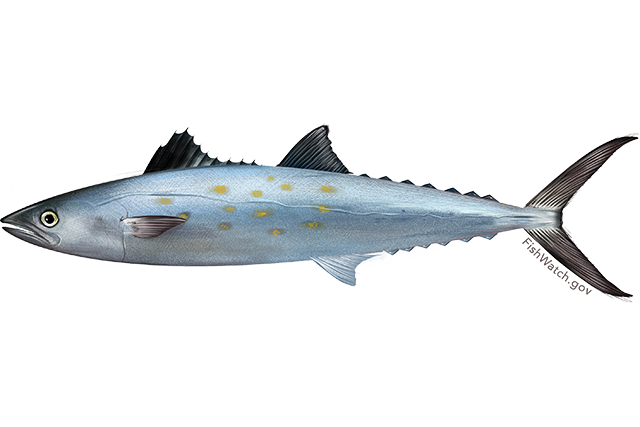Spanish Mackerel
 U.S. wild-caught Spanish mackerel is a smart seafood choice because it is sustainably managed and responsibly harvested under U.S. regulations.
U.S. wild-caught Spanish mackerel is a smart seafood choice because it is sustainably managed and responsibly harvested under U.S. regulations.
Appearance
- Spanish mackerel have a greenish back with silver sides and belly.
- They are covered with very tiny scales.
- They have yellow or olive green oval spots all over. These spots distinguish Spanish mackerel from cero mackerel, which have yellow-gold streaks along their midline.
- Spanish mackerel can be distinguished from king mackerel by their smaller size and the absence of the lateral line that drops abruptly below the second dorsal fin.
Biology
- Spanish mackerel grow fast, up to 13 pounds, and can live up to 12 years.
- They are able to reproduce by age 2.
- There are two distinct populations, one in the Gulf of Mexico and one in the Atlantic.
- They spawn from April to September off the North Carolina and Virginia coasts in the Atlantic Ocean and in shallow coastal waters in the eastern Gulf of Mexico.
- Spanish mackerel release their eggs in batches throughout the spawning season. Females can have 500,000 to 1.5 million eggs over the spawning season.
- Spanish mackerel swim in large, fast-moving schools.
- They migrate as the seasons and water temperatures change.
- Along the Atlantic coast, Spanish mackerel spend the winter off Florida and move northward to North Carolina in early April and to New York in June. As waters cool later in the year, they return south to Florida waters.
- In the eastern Gulf of Mexico, they migrate to the west of Cape San Blas, Florida. They remain in the northern Gulf of Mexico until September and migrate south along the coast in the fall.
- Spanish mackerel prey primarily on herring, menhaden, sardines, mullet, needlefish, and anchovy and, to a lesser degree, shrimp, crabs, and squid. They are often seen forcing schools of small fish into tight bundles and nearly pushing them out of the water when feeding.
- Dolphins and sharks prey on Spanish mackerel.
Where They Live
- Spanish mackerel is found off the Atlantic coast of the United States and in the Gulf of Mexico.
Management
- NOAA Fisheries and the South Atlantic and Gulf of Mexico Fishery Management Councils manage the Spanish mackerel fishery.
- Managed under the Fishery Management Plan for the Coastal Migratory Pelagic Resources in the Gulf of Mexico and South Atlantic Region:
- Commercial fishermen must have a permit to harvest Spanish mackerel in federal waters.
- Annual catch limits are divided between the commercial and recreational fisheries for the Atlantic and Gulf of Mexico stocks. The commercial allocation is 55 percent in the Atlantic and 57 percent in the Gulf of Mexico.
- Seasonal and per-fishing-trip limits.
- Minimum size limit to allow fish time to mature and spawn.
- Spanish mackerel must be landed with heads and fins intact in both the commercial and recreational fisheries.
- Seasons for Atlantic and Gulf of Mexico stocks. Seasons can close early if quotas are reached.
- Prohibition on purse seine and drift gillnet fishing gear.
- Extends management area for Spanish mackerel through the Mid-Atlantic Fishery Management Council's jurisdiction (North Carolina to New York).
- The Atlantic States Marine Fisheries Commission works with the South Atlantic Fishery Management Council to coordinate management of Spanish mackerel fisheries in state waters to ensure they’re managed similarly to the fisheries in adjacent federal waters.

